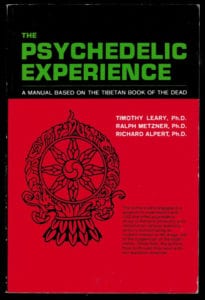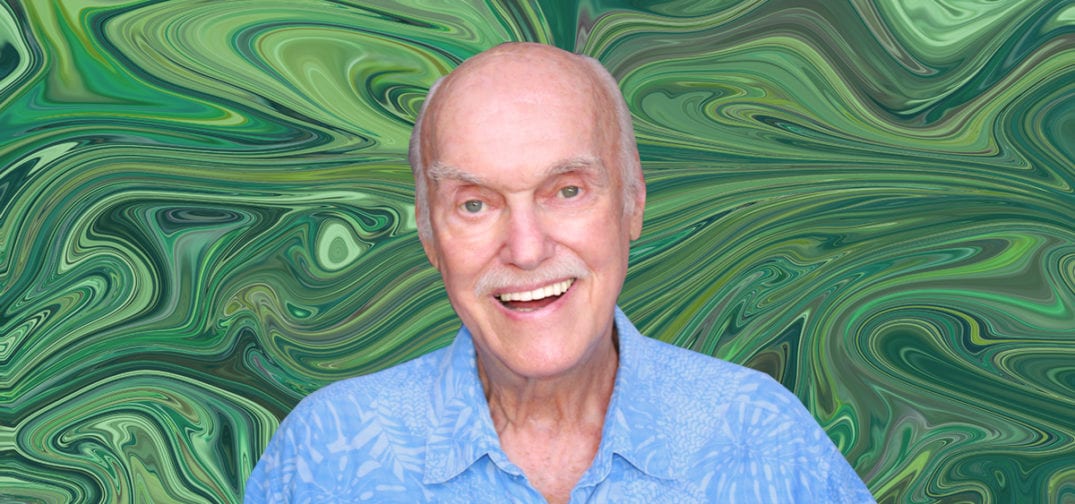On December 22, 2019, Baba Ram Dass passed away peacefully at his garden home in Maui. Today — April 6, 2020 — marks the 89th anniversary of his birth, and as a father of the American psychedelic revolution, we want to honor him to celebrate.
The spiritual teacher first became Baba Ram Dass in the late ‘60s after a search for more led him to India. Then Richard Alpert Ram Dass embarked on a journey with Bhagawan Das through the temples of India. It was in the last temple where they traveled that he met Neem Karoli Baba, or Maharajji, the enlightened man who gave him his name.
Ram Dass means “servant of Lord Rama.” In the Hindu religion, Lord Rama is the seventh incarnation of Vishnu, a god of purity and marital devotion. However impactful this particular meeting was for him going forward, his whole life played a part in the lessons he taught. In his life, Ram Dass says he had three parts. He was an overachiever, he played a huge role in the psychedelic revolution of the 1960s, and finally, he became an Ashtangi; each part was essential in creating the Ram Dass cherished by the world.
Early Days
The psychologist was born Richard Alpert in Newton, Massachusetts. In his spare time, young Alpert was an amateur cellist and didn’t think much of the Jewish religion he was born into. His self-described achiever addiction inspired him to attend medical school at Tufts University. Soon he shifted his studies to focus on psychology, eventually earning his PhD. from Stanford University on the topic.
While studying at Stanford, Alpert developed severe anxiety, which would manifest physically as stomach cramps, diarrhea, and a severe rash between his fingers. During this time he committed himself to five years of psychoanalysis focused on the causes of his homosexuality. At Stanford Alpert learned from mentor David McClelland, and eventually accepted a tenure-track position working underneath him across the country at Harvard University. Before leaving, his psychiatrist informed him that because of his homosexuality he was too sick to function in modern society. But still, he persisted.
At Harvard, McClelland was the head of the Center for Research and Personality with Dr. Alpert serving as his deputy. It was in this research position that Alpert first met Dr. Timothy Leary. On a whirlwind trip to South America, Leary was fated to have his first experience with psilocybin and would bring it with him back to the States. A few months later, back in Massachusetts, Alpert walked from his childhood home over to Leary’s house to ‘turn on’ for the very first time.
The Age of Expanded Consciousness
This first experience with any psychedelic was pivotal for the young doctor: he described seeing the various social ‘masks’ he wore, like scholar and playboy, separate from him. He claimed he learned more in those few hours than he had in a lifetime of scholarly endeavors. This fact alone changed his world forever.
By this point, both Harvard Doctors were focused only on researching the therapeutic potential of psychedelic drugs. They were granted permission to research using graduate students, but rumors flew and the dean caught wind that their studies weren’t blind nor were they conducted only with graduate students. By 1963, both Leary and Alpert had been let go from Harvard.
Alpert, Leary, and their followers began living in houses rented out by Leary until their owners returned from academic leave. They conducted group LSD studies with the goal of cultivating divinity in every person. Their findings were published in the Psychedelic Review. This work culminated in the publishing of a 1964 book written by both Alpert and Leary alongside Ralph Metzger entitled The Psychedelic Experience. In 1966 Alpert co-authored LSD with Sidney Cohen and Lawrence Schiller.

But the age of free hallucinogenics was destined to end sooner or later, and things became much more complicated in 1966 with the passing of the Staggers-Dodd Bill which made LSD illegal nationwide. By the end of 1967, Leary was on his own trip, and Alpert wanted to search for how this innate knowledge could be accessed without psychotropic medicines.
Pursuit of Enlightenment
According to a 1976 ‘Gonzo-style’ Rolling Stone article, Alpert’s final test was to take 400 micrograms of LSD every four hours for three weeks, and after finally coming down he remained unchanged. The Harvard-professor-turned-black-market-psychedelic-dealer knew that there had to be more. He set out to India on an opulent vacation, spending three weeks parading around the Southeastern Asian country in a Land Rover. This luxury halted when he met Maharajji, who gave Alpert his first task: present the guru with the Land Rover as a gift.
In Be Here Now Ram Dass describes how he felt after this meeting, “I cried and I cried and I cried… I felt like I was home. Like the journey was over. Like I had finished.”
After his initial meeting with Maharajji, Ram Dass spent another seven months at the temple. He rose at 4 am daily to work on meditating and deep breathing exercises, practicing raja yoga, reading Hindu texts, eating strictly vegetarian, and abstaining from all sex. He arrived home to Massachusetts barefoot and blissed out in his yoga whites. From that moment forward, Ram Dass could not function within society as it existed, and people noticed. His energy somehow was both enigmatic and transparent which prescribed him a magnetic quality. People were drawn to him, to his understanding, to his main mission: presence and love.
The Legacy of Ram Dass
From this point, his day to day is history, recorded in his many lectures, published books, and television appearances. Baba Ram Dass became a beacon of love for people all over the world, and though he was a fallible human like the rest of us, he was beloved.
Ram Dass left behind a reminder to be loving. His mantra may have continued to evolve from the original psychedelic publishing of Be Here Now, but it always centered around being present and living truthfully in love. That legacy will continue to permeate society as we continue to walk through our own challenges.
For anyone interested in learning more about the teachings of Ram Dass a body of his work — including text, videos, and more — can be found on his website, The Love Serve Remember Foundation.
Get daily cannabis business news updates. Subscribe
End
